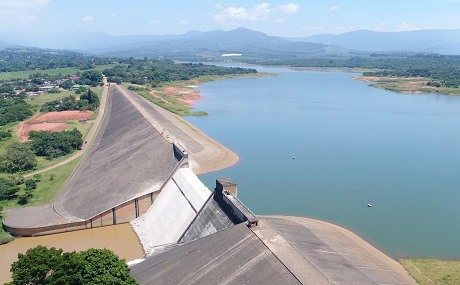It’s cooler and wetter in northeast Limpopo than it has been for a while after rain this weekend but the Tzaneen Dam in the Letaba River is nevertheless lower than last week, a discomforting 12.7% full. The Middle Letaba Dam stands at about 6% (and hasn’t been close to capacity in a long time).
The Tzaneen Dam is an irrigation dam very important to fruit producers. Last summer already citrus producers in Letsitele were concerned and this year the situation doesn’t look much better. In November last year the Tzaneen Local Municipality announced water restrictions and farmers in the Letaba Irrigation Scheme are restricted to half their water allocation.
 Tzaneen Dam (Photo: Department of Water & Sanitation)
Tzaneen Dam (Photo: Department of Water & Sanitation)
Construction work halted after demolition of spillway
On top of low summer rainfall, raising the Tzaneen Dam’s wall has been dragging on for some years and the dam’s capacity has been lowered to 65%.
“We’ve been expecting trouble for a while now,” a farmer tells FreshPlaza. “Rain in the water catchment area is lower than it should be to make a difference to the dam levels and farmers have too little water reserves to take them into winter. We’re on the edge.”
Water security jeopardised by 65% dam capacity
The ongoing construction work – estimated to last at least another 18 to 20 months - means that downstream farmers, for instance citrus farmers in Letsitele, lose 35% of their water buffer to carry them through the winter and early spring, when temperatures can reach 40°C and over but the rain hasn't started.
Due to the time frame of the project, they could be subject to this reduced buffer capacity, on top of the current 50% water restrictions, for another two seasons yet.
Recently the Department of Water Affairs announced it would resume construction work this month, with their own construction team, but at the time of writing it didn’t look to have resumed.
Citrus orchard in Letsitele
Letaba Water Users’ Association lauded for proactive measures
Citrus producers in the Letsitele area receive water from the Tzaneen Dam via the Great Letaba river and canal systems, managed by the Letaba Water Users' Association, whose self-regulating system of water restrictions whenever the Tzaneen Dam ceases to overflow (which now, unfortunately, happens much sooner than before) has been held up as a model of good water governance to other water-stressed areas in South Africa like the Western Cape.
The larger Tzaneen and Magoebaskloof areas, major avocado, mango, banana and macadamia production regions as well as important water catchments, have always had exceptionally moist and misty climates with an average of 900 to 1,200mm of annual rainfall (and more in parts of Magoebaskloof). Longtime Tzaneen residents tell of clothes and shoes growing mouldy during summer.
This year, the first part of summer has delivered only 200 to 300mm around Tzaneen.
“I am convinced we will get between 600 and 900mm of rain this summer,” declares an avocado farmer from Tzaneen. “That’s a below average rainfall year and it spells trouble for the farmers in Letsitele who are downstream from us and dependent on runoff from our side.”
Avocado orchard in Tzaneen
Higher springtime temperatures strain water resources
While it is widely acknowledged that South Africa is currently in a dry El Niño cycle, which is part of a longterm climate pattern of wet and dry fluctuations, one thing that has changed, producers say, are maximum springtime temperatures.
“The last few years we easily get 40°C in early spring, from about September to November, before it’s started raining, and it has an enormous impact on flowering, fruit set and water usage. Evapotranspiration is immensely high during these periods, placing tremendous pressure on water resources and primary water users in our area,” notes an avocado farmer.
Banana plantation in Tzaneen
For more information:
Letaba Water Users' Association, Tzaneen
Tel: +27 15 307 2651
Email: [email protected]
